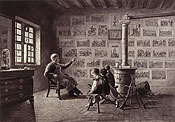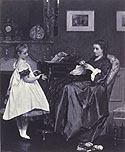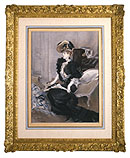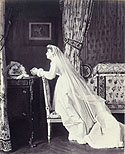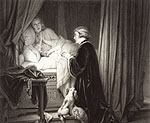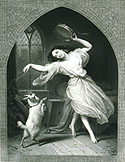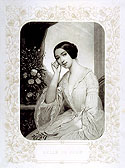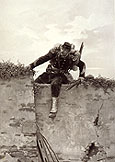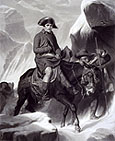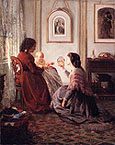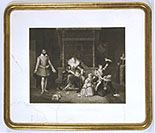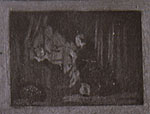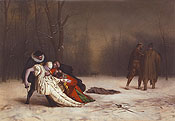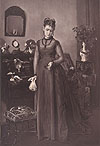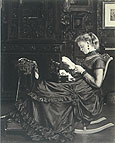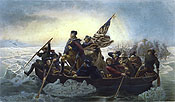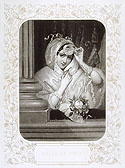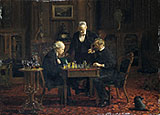The browser will either open the file, download it, or display a dialog.
|
Please note: selected figures are viewable by clicking on the figure numbers which are hyperlinked.
|
||||||||||||||||||||||||||||||||||||||||||||||||||||||||||||||||||||||||||||||||||||||||||||||||||||||||||||
|
|
The Image on the Wall: Prints as Decoration in Nineteenth-Century Interiors |
|||||||||||||||||||||||||||||||||||||||||||||||||||||||||||||||||||||||||||||||||||||||||||||||||||||||||||
|
In the nineteenth century, the production of prints became an industry. Manufactured and available everywhere but in the remotest parts of the world, prints constituted an affordable commodity. The global production of, and trade in prints was fostered by an informal, worldwide network of print publishers and dealers. The house of Goupil, established in Paris in 1827 and active until 1921, was one of the most important agents in this network1. Goupil selected potentially popular subjects, made them available in a vast array of formats, and distributed them in Europe and the United States. As early as 1848, the firm opened a branch in New York (the first of its kind), and it opened another in 1852 in Berlin. By the end of the 1860s, either through merger or acquisition, it was also operating in London, The Hague, and Brussels. The collection of the Musée Goupil in Bordeaux consists of the remaining stock of the firm: 46,000 prints and 70,000 photographs, most of which are reproductions of works of art, especially Salon paintings. It provides a unique resource for the study of images and visual culture, generally, in the nineteenth century. | |||||||||||||||||||||||||||||||||||||||||||||||||||||||||||||||||||||||||||||||||||||||||||||||||||||||||||
|
Cheap lithographs, expensive line engravings, photographs, and photomechanical impressions—there was a picture for everybody. As intense as was the conflict between printmakers and photographers in the second half of the nineteenth century within the art world,2 it is doubtful that the general public paid much attention to the techniques used to make reproductions. Nowadays, these images are seen either as documentation of lost paintings or vestiges of an old-fashioned art form, the reproductive print. They also appear to cultural historians as symptoms of the media explosion of the second half of the nineteenth century, which relied heavily on the advent of photography and printing processes derived from it. Rarely are they thought of in the context for which they were actually created: the decoration of interiors. Produced by the hundreds of thousands,3 these images liberated themselves from the obscurity of the portfolios where amateurs used to confine them. They appeared in full light, adorning the walls of the homes of all classes, from the more prosperous members of the working class to the aristocracy. Prints and photographs were ideally suited to the modest size of the average nineteenth-century apartment. As early as 1824, Stendhal remarked, somewhat bitterly, "By tearing down mansions and destroying castles, our modern standards make the taste for paintings impossible; only prints are useful to the public, which consequently encourages their production."4 Reproductive prints became a highly desirable commodity. Frivolous, they nurtured the desire for dream and fantasy which, according to Walter Benjamin, characterized nineteenth-century interiors.5 More seriously, they could serve educational purposes, as the American critic Clarence Cook set forth:
The idea for the show from which this article derives was inspired by visitors to the Musée Goupil. During gallery talks, there is always someone who mentions that s/he already knows this or that print, because it used to hang on the walls of his/her grand-parents' living room, or because s/he saw it in a dictionary or a textbook as a child. As a result, I felt there was an obscure corner of our collective memory that needed to be explored. Surprisingly, hardly a trace of the decoration of ordinary homes appears in conventional archives. French estate inventories sometimes mention prints "in gilt frames," but usually fail to describe them in detail. Due to technical limitations, photographs of average interiors hardly exist before the end of the century. A better record survives in genre paintings and literature. Witnesses to the proliferation of images in the western world, painters and writers carefully selected those they cited in their works, purposefully choosing commonplaces of the time. Even if sometimes satirical, these representations give an idea of the choice of images and their installation in ordinary dwellings. |
||||||||||||||||||||||||||||||||||||||||||||||||||||||||||||||||||||||||||||||||||||||||||||||||||||||||||||
| Pasted or Framed Usually, cheap images were not framed but merely pasted or pinned on the walls. In Old Memories (Vieux Souvenirs), a photogravure after Jean P. Haag's painting (fig. 1), an old Napoleonic soldier, who lost his leg on the field of battle, recounts his memories to three young boys. He relies upon an amazing series of inexpensive lithographs devoted to the whole legend of the emperor. These "images d'Épinal" are pasted on the wall and cover it almost entirely, as would a wall-paper. Installed chronologically, the pictures serve an educational purpose.7 The only visible frame, at the center, contains medals and other memorabilia, indicating that these are more valued than the images. |
||||||||||||||||||||||||||||||||||||||||||||||||||||||||||||||||||||||||||||||||||||||||||||||||||||||||||||
| In more comfortable, bourgeois settings, such as the one Gustave De Jonghe painted in his Woolwinders (Les Dévideuses, fig. 2), prints often appear framed and hung symmetrically. This installation conveys an idea of harmony that was (and remains) essential to the canons of classical interior decoration. The frames represented here, certainly made of wood with rounded corners, are very typical of the second half of the nineteenth century—many examples have survived (fig. 3).8 Frames were intended to provide the necessary harmony between the prints and the room where they were hung, and they were often considered more important than the prints themselves. They even dictated aspects of interior decoration. Framers' manuals typically recommended appropriate colors for the walls: "dark green, garnet-colored, brown and Russian leather are generally the most favorable colors to enhance gilt frames."9 | ||||||||||||||||||||||||||||||||||||||||||||||||||||||||||||||||||||||||||||||||||||||||||||||||||||||||||||
| Throughout most of the nineteenth century, framed prints were not matted, but were glued or laid down onto a piece of cardboard, which kept them flat. It was not until the late nineteenth century that mats were introduced. Goupil, like many other publishers, had their own framing workshop. In the Musée Goupil's collection, a matted photogravure after Giovanni Boldini is the only surviving example of this workshop's production (fig. 4). This kind of gilt and blue mat was often used for 18th-century drawings. The rococo revival frame and lined mat give the inexpensive photogravure the appearance of a valuable object, akin to a master drawing. This was typical of that era, which developed a special taste for mock materials—fake leather, fake marble, silver-plated in place of sterling silver. Because they were produced by the industry and by way of high-technology processes, these products were perceived as quintessentially modern. The idea of industrial reproduction of works of art was very much part of this culture of imitation. | ||||||||||||||||||||||||||||||||||||||||||||||||||||||||||||||||||||||||||||||||||||||||||||||||||||||||||||
| Pictures within the Picture Representations of contemporary interiors were a popular sub-category of genre painting in the second half of the nineteenth century. Such paintings, often featuring mothers and children in opulent bourgeois settings, not only inform us about the use of images in interiors, but also exemplify and were part of the nineteenth-century economy of images. As Salon paintings were reproduced in prints or photographs to be hung in domestic parlors, these parlors, in turn, would become a subject for new paintings, which would themselves be transformed into images, marketed as interior decoration. Over and over this process repeated itself. As art was disseminated throughout the world in greater and greater quantities, it would begin to be reused and recycled at an accelerated pace. |
||||||||||||||||||||||||||||||||||||||||||||||||||||||||||||||||||||||||||||||||||||||||||||||||||||||||||||
|
Prayer of the Bride (La Prière de la mariée, fig. 5), by the Belgian painter Charles Baugniet, shows a young bride praying in a bedroom before going to her wedding. Hanging above her is a print, in a wide and probably expensive frame (fig. 6). The subject of this print is very well-known: it is a line engraving after Paul Delaroche's famous painting, Children of Edward IV praying in the Tower (Les Enfants d'Édouard, fig. 7). Prints after Delaroche's dramatic and barren history paintings were ubiquitous at the time. Print connoisseur and collector Henri Béraldi, with his usual cold irony, described an apartment with prints after Delaroche in every room:
Beyond the biting humor, Béraldi's remark shows how popular these prints were and how well their subjects were understood, which is certainly no longer the case today. Children of Edward IV is set in 1483. The two young boys, heirs to the throne of England, are about to be murdered by order of their uncle, soon to reign as Richard III. Baugniet appears to have included Delaroche's print to underscore the meaning of his painting, something that he did in other genre paintings as well. The bride and one of the young princes have exactly the same pose, and the setting is very similar (the bedroom, with the large canopied bed). The inevitable conclusion is that these characters will share the same fate: they all are going to die, even if this is only allegorical in the case of the bride. According to the nineteenth-century morality, marriage signified the loss of women's virginity, and therefore the death of the maiden and the birth of a new incarnation, the wife, soon to be mother. This theme also relies upon a motif common in the nineteenth century: the innocent maiden abandoned to a brutal husband. |
||||||||||||||||||||||||||||||||||||||||||||||||||||||||||||||||||||||||||||||||||||||||||||||||||||||||||||
|
Next to Delacroche, his student Jean-Léon Gérôme was one of the French artists whose works were the most reproduced and disseminated all over the world through prints and photographs. The fact that he was Goupil's son-in-law certainly contributed to this achievement. According to Émile Zola, "there is barely a parlor in the provinces which does not have a print after The Duel After the Masquerade" (fig. 8).11 A success at the Salon of 1857, this was Gérôme's most popular composition. From 1859 to 1888, Goupil published no less than nine different reproductions of A Duel After the Masquerade (Un duel après le bal) in every conceivable size, format and technique.12 One of these appeared in a painting by Jules Émile Saintin, Indecision (Indécision, fig. 9), together with a reproduction after a painting by Saintin himself, Deuil de Cœur (fig. 10). Artists would sometimes quote themselves, which was a lucrative idea because it publicized the reproductions made after their works. Moreover, Saintin re-used Deuil de Cœur in another picture, Memories (Les Souvenirs, fig. 11). A third picture appears in Indecision; it is a reproduction of Alexandre Cabanel's The Florentine Poet (Le Poète Florentin). | |||||||||||||||||||||||||||||||||||||||||||||||||||||||||||||||||||||||||||||||||||||||||||||||||||||||||||
| The interplay among the images creates a loose narrative. A woman stands before the window, confused, not knowing whether to stay or to go. Maybe she thinks of Gérôme's two men fighting to the death, behind her on the wall—maybe she knows two men who fought a duel. Undecided in her sentimental life, maybe she thinks of her own love memories, just like the woman in Saintin's Deuil de Cœur. Confronted with such melancholia, she might seek refuge in the golden age of Renaissance, as evoked in Cabanel's Florentine Poet. The old themes of Love, Death and Romance are constantly re-dramatized, just as the pictures themselves are constantly reproduced and recycled. | ||||||||||||||||||||||||||||||||||||||||||||||||||||||||||||||||||||||||||||||||||||||||||||||||||||||||||||
|
Pictures within Narratives
Neat, comfortable, and bourgeois, with a touch of "English cleanliness," this setting exemplifies all of Emma Bovary's aspirations. For Flaubert, the mildly eroticized Esmeralda, with her bare legs, provided a décor appropriate to the scene he invented: while Esmeralda dances on the wall, Guillaumin is trying to seduce Emma, softly caressing her arm. |
|||||||||||||||||||||||||||||||||||||||||||||||||||||||||||||||||||||||||||||||||||||||||||||||||||||||||||
|
In Life on the Mississippi, Mark Twain alludes to Washington Crossing the Delaware. According to him, the Goupil engraving after Emmanuel Leutze's melodramatic painting (fig. 13), along with other historic and biblical images, was present in the dwellings of the "wealthiest and most conspicuous citizens" of every community along the river:
Some of the other prints Twain noted might have been published by Goupil, too: Napoleon Crossing the Alps is an 1852 print by Alphonse François after Delaroche (fig. 18); Moses Smiting the Rock is an original lithograph by Jean-Jacques Champin (1851); Return of the Prodigal Son is a line engraving by Paul Girardet after Édouard Dubufe (1869).16 The general atmosphere of gravity that emanates from Twain's description of mid-nineteenth-century American interiors with their accumulation of biblical, patriotic, and historical images is not too different from the gloom and doom in Béraldi's satirical evocation of a French interior full of prints after Delaroche. |
||||||||||||||||||||||||||||||||||||||||||||||||||||||||||||||||||||||||||||||||||||||||||||||||||||||||||||
| Pairs and Pendants A marketing strategy popular among art publishers in the nineteenth century was the creation of pendants, which fostered the sale of two prints instead of one. For the customer, pendants guaranteed a coherent decoration, usually installed symmetrically. Such an installation can be seen in De Jonghe's Woolwinders (fig. 2), with a pair of unidentified prints. The arrangement of images often relied on trite relationships between them, which sometimes evoke the entries Flaubert wrote for his Dictionary of Accepted Ideas. If there is Belle de jour (fig. 14), there has to be Belle de nuit (fig. 15). If one were to ask: "Where are they?" (Où sont-ils ? , fig. 16), the immediate answer would be "There they are!" (Les voilà !, fig. 17). These pairings shaped the image of a perfect world, with everything in its place, and a place for everything. |
||||||||||||||||||||||||||||||||||||||||||||||||||||||||||||||||||||||||||||||||||||||||||||||||||||||||||||
| Though pendant prints were often based on pendant paintings, the pairings were sometimes conceived by the publishers rather than by the artists. Well-known for his Bonapartist sympathies, Goupil published Delaroche's General Bonaparte Crossing the Alps (Le Général Bonaparte Franchissant le Mont Saint Bernard, fig. 18) and Horace Vernet's Emperor Napoleon III (Napoléon III Empereur des Français, fig. 19) as a pair. It would allow each of its buyers to make a clear political statement in favor of the continuity of the Empire. | ||||||||||||||||||||||||||||||||||||||||||||||||||||||||||||||||||||||||||||||||||||||||||||||||||||||||||||
| In a quite different genre, Alone...At Last! (Enfin...Seuls !, fig. 20) and The Layette (La Layette, fig. 21), are made after paintings by different artists, Eduardo Tofano and Auguste Loustaunau. The pairing of these two reproductive prints produced an obvious narrative in conformity with bourgeois morality. In a perfect and happy world, the birth of a child follows a wedding. To underscore the meaning of this pair, Goupil did not hesitate to change the title of one of the works. He substituted the original title Alone! (inscribed in the catalogue of the 1878 Salon) to the more commercial Alone…at Last! to better stimulate the customer's imagination. It is impossible to know whether he commissioned The Layette as a pendant to Alone…At Last!, or merely spotted it and fabricated this sequence, which would allow him to capitalize on the enormous success of Alone…At Last!17 In either case, Goupil's strategy epitomized a most important shift in the economy of the art world: the decline of the authority of the Academy, and the rise of an increasingly powerful and demanding market. | ||||||||||||||||||||||||||||||||||||||||||||||||||||||||||||||||||||||||||||||||||||||||||||||||||||||||||||
| * * * * * * * * * * * * * | ||||||||||||||||||||||||||||||||||||||||||||||||||||||||||||||||||||||||||||||||||||||||||||||||||||||||||||
| The shockwave generated in the second half of the nineteenth century by the combination of a media explosion and the rise of the international art market eventually led to a reorganization of hierarchies in art. But for a few decades, from the 1840s to the 1860s, every kind of picture at every price range could coexist and be distributed through identical channels, those operated by the firm of Goupil and its counterparts all around the world. For a while, the utopia of industrial progress fuelled the dream of an alliance between connoisseurs and laymen, in conformity with the ideology of Saint-Simonism, which was central to the Second Empire. In the realm of images, industrial progress would allow the production of valuable prints at low prices, in a true spirit of democratization of the fine arts—the very dream which many avant-gardes of the 20th century pursued. However, economics and the market soon imposed their laws, and fostered the production of cheap imagery, more and more disconnected with serious art practice. This was probably the first act of what became famous one century later as the media and entertainment industry. | ||||||||||||||||||||||||||||||||||||||||||||||||||||||||||||||||||||||||||||||||||||||||||||||||||||||||||||
| What also remains of these experiments in the massive dissemination of art is an impressively wide range of images. They formed the solid basis of the visual culture of the nineteenth century, which we have inherited, both in Europe and in the United States. Painters like Delaroche and Gérôme epitomized this revolution of images, not only because they were so influential among their students, but also because the reproductive prints and photographs after their works were ubiquitous. They would adorn many parlors in the western world, including the United States, as can be seen in two American interior scenes, Aaron Drapper Shatuck's The Shattuck Family (fig. 22) and Thomas Eakins' The Chess Players (fig. 23).18 Because the images they produced remain part of our collective unconscious, Delaroche and Gérôme, as well as their epigones, appear today as milestones of the new, global, modern western culture which took shape in the second half of the nineteenth century. | ||||||||||||||||||||||||||||||||||||||||||||||||||||||||||||||||||||||||||||||||||||||||||||||||||||||||||||
|
This text is an abridged version of my exhibition catalogue Une image sur un mur. Images et décoration intérieure au 19e siècle (Bordeaux: Musée Goupil, 2005). Part of it was presented at the CAA 94th Annual Conference, Boston, February 22–25, 2006 (session "Prints in the 19th Century, Part 2," chaired by Patricia Mainardi, to whom I am grateful for her kind invitation). 1. For a chronology and other information on the house of Goupil, see: Musée Goupil, État des lieux, no. 1 and no. 2 (Bordeaux: Musée Goupil, 1994 and 1999), and Hélène Lafont-Couturier, Pierre-Lin Renié & DeCourcy E. McIntosh eds., Gérôme & Goupil: Art and Enterprise, Exh. cat., Bordeaux: Musée Goupil; New York: Dahesh Museum of Art; Pittsburgh: Frick Art & Historical Center (Paris: RMN, 2000). 2. On this conflict, see my essay: "The Battle for a Market: Art Reproductions in Print and Photography from 1850 to 1880," in Kathleen S. Howe, ed., Intersections. Lithography, Photography and the Traditions of Printmaking (Albuquerque: University of New Mexico Press, 1998), 41–53. 3. Goupil's general catalogues list 1,719 available items in 1847; 3,196 in 1856; and 4,087 in 1864—and they had many competitors. In addition, prints in limited editions only appeared at the end of the nineteenth century. Before, the policy was the dissemination and multiplication of images, rather than their rarefaction. Publishers had plates printed over and over, as long as they remained on demand. 4. Stendhal, "Critique amère du Salon de 1824 par M. Van Eube de Molkirk," Le Journal de Paris, September 2, 1824, reprinted in Salons ( Paris: Le Promeneur, 2002), 67–68. "Nos mœurs nouvelles, en abattant les hôtels, en démolissant les châteaux, rendent impossible le goût des tableaux; la seule gravure est utile au public, et par conséquent peut être encouragée par lui". 5. Walter Benjamin, The Arcades Project, ed. Roy Tiedemann, trans. Howard Eiland and Kevin McLaughlin (Cambridge, MA: Belknap Press, 1999). See section I ("The Interior, The Trace"), and especially fragment I1, 6. 6. Clarence Cook, The House Beautiful (New York: Charles Scribner's Sons, 1881), 49. I thank DeCourcy E. McIntosh for this reference. 7. The meaning of Haag's painting is clearly political. It must be read in the context of the harsh, nationalistic reaction to the lost war against Prussia in 1870 and the contemporary desire for re-conquest of the lost territories. 8. Such examples of nineteenth-century prints (or photographs) in their period frames are rarely found in museums, where these images were generally unframed for conservation reasons, thus depriving historians of important information on the usage of these prints. 9. J. Saulo and [?] de Saint-Victor, Nouveau manuel complet du fabricant de cadres, passe-partout, châssis, encadrements, etc., Encyclopédie Roret (Paris: L. Mulo, 1896), 169. "Les couleurs vert foncé, grenat, brun et cuir de Russie sont en général les plus favorables pour faire valoir les bordures dorées." For frames, gilt was the most popular finish in the nineteenth century. 10. Henri Béraldi, Les graveurs du 19e siècle, 1885-1892, vol. 7, 179 (reprint: Nogent-le-Roi: Lame, 1981). "Les estampes sont un succédané des tableaux et des dessins, à l'usage des fortunes modestes ; mais, quelle que soit la valeur de leur exécution, elles ne forment, appliquées sur les murs des appartements, qu'une décoration froide et triste. Nos grands-pères du XVIIIe siècle s'étaient avisés de remédier à cette tristesse par la recherche des sujets galants […]. Cent ans, dix révolutions et Paul Delaroche ont passé là-dessus : nous sommes devenus sérieux, ah mais ! […] Examinez les ameublements contemporains et regardez les sujets des gravures exposées dans toutes les pièces. Antichambre : Richelieu faisant remorquer au supplice Cinq-mars et de Thou : en face : Mazarin mourant. Salle à manger : Le dernier repas des Girondins. Salon : Épisode de la Saint-Barthélémy et Cromwell devant le cercueil de Charles Ier. Cabinet de Monsieur : Lord Strafford marchant à l'échafaud et L'Exécution de Jane Grey. Chambre de Madame : La Cenci allant au supplice et Marie-Antoinette sortant du Tribunal révolutionnaire. Chambre des bébés : Martyre chrétienne et La dernière prière des enfants d'Édouard. C'est le comble de la vieille gaieté française". 11. Émile Zola, "Nos peintres au Champ de Mars," 1867 (Reprinted in Écrits sur l'art. Paris: Gallimard, 1994, 184): "Il n'y a pas de salon de province où ne soit pendue une gravure représentant le Duel au sortir d'un bal masqué." 12. From a 50 cents small carte de visite photograph to a big hand-colored lithograph by Achille Sirouy, sold for 24 francs. See Gérôme & Goupil, 80–89, 156. 13. See Renié, Une image sur un mur, 46–61. For a broad study of the relationships between literature and images in the nineteenth century, see Philippe Hamon, Imageries: Littérature et image au 19e siècle (Paris: José Corti, 2001). 14. Gustave Flaubert, Madame Bovary, part 3, chap. 7 (1857), translated by Eleanor Marx Aveling. "Un large poêle de porcelaine bourdonnait sous un cactus qui emplissait la niche, et, dans des cadres de bois noir, contre la tenture de papier chêne, il y avait la Esmeralda de Steuben, avec la Putiphar de Schopin. La table servie, deux réchauds d'argent, le bouton des portes en cristal, le parquet et les meubles, tout reluisait d'une propreté méticuleuse, anglaise ; les carreaux étaient décorés, à chaque angle, par des verres de couleur. – Voilà une salle à manger, pensait Emma, comme il m'en faudrait une." Steuben painted two Esmeraldas (Salons of 1839 and 1841). They were engraved by Jazet (each in two sizes) and published by Goupil. Both are mildly eroticized, showing Esmeralda bare-legged. There is no record of any Potiphar by Schopin before the Salon of 1866, nine years after the publication of Madame Bovary. Intentionally or not, Flaubert may have confused several biblical compositions: Steuben's Joseph and Potiphar, Schopin's Rebecca, and Vernet's Thamar, for instance. All these were available as prints and very popular at the time. 15. Mark Twain, Life on the Mississippi, (1883; reprint, New York: Bantam Books, 1981), 187. For a discussion of the popularity of Washington's pictures, see DeCourcy E. McIntosh, "Fair and Square in the 1860's: a Meditation on the Worth of an American Icon," Antiques 169, no. 2, February 2006, 68–73. 16. The titles given by Twain are generic enough, so they could refer to prints other than Goupil's. However these were quite popular. The fact that the techniques don't match reflects the usual inaccuracy of literary descriptions: "engraving" (gravure, in French) was mostly used as a generic term (as it often is nowadays), and could refer to any kind of printed image, including photographs and photomechanical impressions. 17. As evidence of this success, Goupil's reproductions of Alone…At Last! were available in 12 different formats, priced from 1 franc (cabinet card photography or small photogravure in the Estampes Miniatures series) to 60 francs (for a color impression of the Varin brothers' line engraving). 18. Aaron Draper Shattuck's The Shattuck Family (New York: Brooklyn Museum, 1865) features Achille-Louis Martinet's line engraving after Delaroche's Virgin and Child (1844), published by Bulla in 1850. In Thomas Eakins' The Chess Players (1876, The Metropolitan Museum of Art), hangs a reproduction of Gérôme's Ave Caesar (1859), possibly Robert Bingham's photograph published by Goupil in 1859. See respectively: Barbara Dayer Gallati, "The Shattuck Family: Aaron Draper Shattuck's Experiment in Narrative Content." American Art Journal 20, no. 3, (1988): 37–47, and Darrel Sewell, ed., Thomas Eakins, Exh. cat., Philadelphia: Philadelphia Museum of Art (New Haven: Yale University Press, 2002), 24–25, 58.
|
||||||||||||||||||||||||||||||||||||||||||||||||||||||||||||||||||||||||||||||||||||||||||||||||||||||||||||
|
||||||||||||||||||||||||||||||||||||||||||||||||||||||||||||||||||||||||||||||||||||||||||||||||||||||||||||


